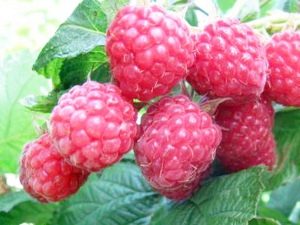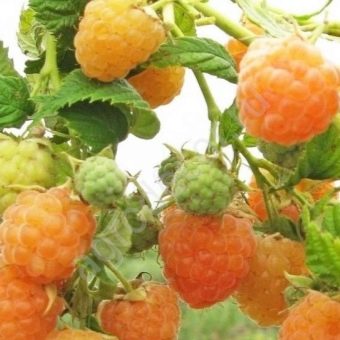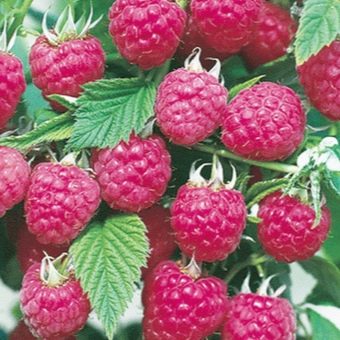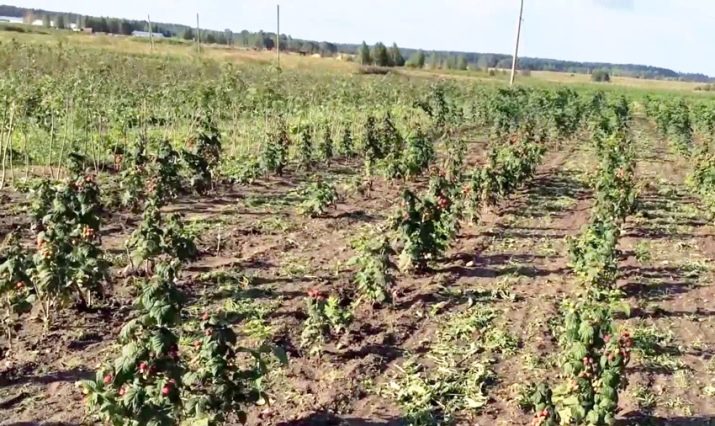Description of the penguin raspberry: what are the advantages and disadvantages of the variety?

Raspberry varieties "Penguin" is a remontant plant.This berry is excellent against various fungi and diseases, and bred it in 2006. A detailed description of the variety will be considered below.
Features and varieties
The raspberry bush grows about 130–140 cm high. It has strong shoots, does not require a garter and holds itself perfectly. The bush is studded with thorns, they are large and dark. But after several years, the spikes become much smaller. On a bush, brushes of 7–10 berries are formed simultaneously.
They practically do not give shoots, since all efforts and resources are directed to the harvest. They are also special in that they are able to survive the frosts to -25 degrees, but at the same time they do not like dryness.
The berries serve as a decoration for the bush, they are very beautiful, there are many of them and they look wonderful. They have round-shaped berries, dark crimson color. They do not fall from the bush, even being overripe or even withered. Raspberry bushes of the “Penguin” variety can be considered decorative, they not only have high yields, but also look amazing. They will decorate your site.
There are such varieties of varieties as "King Penguin" and "Yellow Penguin". The last option is a new kind of raspberry that does not require a garter. Because of this, growing bushes is much easier. This variety of raspberry requires less attention and diligence, not as whimsical to care as other varieties.
The bushes of the "Yellow Penguin" are oversized, reaching a height of one and a half meters. This species is much less susceptible to disease and has a very large crop. This is a stem view, it has a few shoots, only 2-3, but they are very powerful. At the same time yield a crop equivalent to the bush varieties.
The berries are very large and reach a weight of 7–8 g. The berries are dense and round. Even when growing this type of raspberry in a darkened place, it has a very pronounced dessert taste, with a barely noticeable and very pleasant sourness, which only emphasizes its virtues.
The yellow penguin tolerates transportation. Suitable for freezing and eating raw. It gives every year a big harvest from July and right up to October.
"King penguin" is also a new raspberry species and is very high-yielding. It, like the Yellow Penguin, is very compact, but its height reaches 1.7–1.9 m. And the weight of one berry can be up to 10–11 g. They are very large, with a pronounced red color and break easily.
After the berries have ripened, they can remain on the bush for another 5 days and not lose their quality. If you plant bushes in a sunny place, have a very sweet taste. With one bush you can harvest up to 9-11 kg. Berries ripen from July to October.
This variety has its advantages. First and foremost - resistance to cold. It can tolerate temperatures up to -33 degrees. It is also very resistant to diseases and various crimson pests.
Due to the fact that these bushes grow up, they look very aesthetically pleasing, since they do not grow randomly throughout the site. And he has a very high yield. These bushes do not require any special care. Planting is the same as for ordinary bushes raspberry varieties "Penguin".
The benefits of raspberries
In raspberry berries a large amount of a wide variety of vitamins and useful organic substances. From them you can get essential oils. This berry is indispensable during a cold. It strengthens the body and can even beat down the heat during the illness. It is a natural analogue of aspirin.
Raspberry enhances all metabolic processes in the body and cleans it. That is why it is recommended to use those who want to lose weight. Also, the berry has a beneficial effect on the hair, accelerating the process of their growth and strengthening them.
Advantages and disadvantages
Like every plant, the penguin variety raspberry also has its advantages and disadvantages. To the first can be attributed her early ripeness. Already in June you will harvest the first harvest, and in August the second. It withstands severe frosts, thanks to which freezing in the middle lane becomes almost impossible.Gives a big crop and at the same time does not demand big efforts for leaving.
But there are drawbacks, for example, mediocre taste. It can be made richer by proper planting on the sunny side and regular fertilizer. The bush will tolerate the winter well, only if it is completely cut off before the onset of cold weather.
Planting and reproduction
Try to give the site more attention, because the taste of this raspberry variety depends on how and where you plant it. You need to choose the sunniest place on the site. Before planting add dolomite flour to the soil. If you plant raspberry bushes in the fall, then you still need to add superphosphate. They fertilize them in the autumn, because it dissolves for a very long time, and the plant needs it from the very beginning. If you fertilize the soil with it in the spring, it simply does not have time to completely dissolve.
If there is a lot of clay in the ground, and the ground itself is heavy, plant bushes in raised beds. First, you need to dig a trench to a depth of 30 cm and a width of about 35–55 cm. After that, put plant waste at its bottom - cut branches of trees, leftovers from the kitchen, last year’s grass. Mix the ground you dug and compost into one to one. You can also add old sawdust or crushed bark there: this is done to loosen the soil.
In conclusion, fill this trench with this mixture, as a result you will have a bed of about 13–20 cm in height. So that it does not crumble, you can install a box on either side. The variety of raspberry "Penguin" is unpretentious, however, and here you need to be able to properly care for the plant, so as not to harm him. In this species, maturation passes very quickly, for this very reason, due attention must be paid to the fertilization of the bushes. During planting, observe the distance between plants up to 70 cm, and between the beds, leave a passage 1.5–2 m wide.
Like all plants, raspberries need timely watering, removal of weeds and loosening the ground. So that you have a rich harvest, you need to fill the soil with nitrogen, this is done with the help of fertilizers.
To grow large berries, the bushes need to leave only a couple of pieces of shoots, the rest should be removed with the arrival of spring. To speed up the process of sprouting, you need to clear the area with raspberries from snow in the spring and create a greenhouse. Cover your site with a film and then the process will go much faster.
Unfortunately, this variety gives few shoots, it creates problems for its reproduction. To stimulate the growth of shoots, it is recommended that the bushes have reached two years of age, in early spring to cut the shoots. After a short period of time, raspberry bushes will give a lot of new shoots, you can use them for breeding and growing new bushes.
The ideal size of the shoots - no more than 5 cm in height. If they nevertheless grew by 11–16 cm, then they will take root much worse, since large variants are not suitable for reproduction. Dig a stalk and carry it with a lump of earth. Remember that you can not root it with water, in this case, the sprout just disappear.
Preparing for the winter
It is necessary to prepare raspberry bushes for winter in the fall, until it is cold. If you cut the raspberries into two crops, then in this case you need to bend down to the ground and cover. To do this, you need to stretch the wire along the bushes. This should be done at a height of 33–38 cm from the ground. Then tie to the wire shoots. Cover the bushes, you can use regular plywood, thick paper, or even resort to roofing felt.
If you have a snowy winter, then you need to ensure that the bushes are always covered with a layer of snow not less than half a meter. During the cold season, try to follow this and pour snow. Watch and so that the top does not form an ice crust.
Pruning bushes
If you properly care for and trim raspberry bushes, then they greatly reduce the risks of various diseases. If you want to collect one, but very fertile crop, raspberry bushes "Penguin", should be cut at the root, in the fall.In the spring, it will give new sprouts from which you will again be able to harvest.
If you want to harvest both in summer and autumn, leave annual shoots, and after that, in the spring, cut off dry and frozen branches. Keep in mind that if a bush produces a crop twice a season, its load increases. Such plants need more attention.
Pests and diseases
This variety is quite resistant to various diseases and pests. But still sometimes the bushes can get sick. Diseases of the Penguin variety include diseases such as gray rot, purple spot, anthracnose and ulcer spot.
In order to prevent diseases, raspberry bushes are treated with fungicides in spring. One of the most famous, is a 3% solution of Bordeaux mixture. The second treatment should be carried out in the autumn, then when you harvest the entire crop.
Bushes can spoil the pests: raspberry beetle, weevil or raspberry moth. But this problem can be avoided thanks to the so-called plant medic. These plants should be planted near the raspberry bushes. These can be plants such as dill, tansy or beans.
Harvesting
After about 3-4 weeks of flowering, the fruits of the raspberry begin to ripen. They become softer and well separated from the bush. At this time with the harvest you need to be very careful, the fruits of raspberry, stored for the first few days after harvest. If the berries are stored for a longer period of time, they begin to lose their appearance, become soft and rotting.
Berries ripen for 4-5 weeks, starting in June. The second harvest from the raspberry variety "Penguin" can be collected in August. But perhaps this is only with proper care of the bushes. You need to remove the berries every 3-4 days, and then you will have a good and high-quality harvest. But there are cases when the berries can be harvested daily, usually this happens when the temperature is high outside.
Need to collect by hand, because the berries are very fragile and easy to damage. The process is not easy, but worth it. After collecting, try as quickly as possible to decompose raspberries in portions in small containers, 200 g or a little less.
Gardeners reviews
This raspberry variety is not yet very popular in our country. But many have already appreciated the "Penguin" for its beautiful appearance, high yield, resistance to disease and weather conditions. This raspberry perfectly tolerates frosts, for this very reason its extinction is almost completely excluded, especially when it comes to central Russia.
In general, the variety has fairly good reviews, however, there are some not very positive ones. They are connected with the fact that the berry has a prolonged fruiting and a dull taste due to the small amount of sugar. Even in the “Penguin” variety it is difficult to reproduce due to the small number of root offspring, this affects the difficulty of breeding shrubs.
The advantages of the variety are good yield, high quality berries, low cost of seedlings. One of the main advantages can be considered that it does not need to apply agricultural techniques. Many gardeners believe that this is a good option for people who can not or do not want to devote a lot of time to the bushes.
"Penguin" is really a unique variety. It does not require complex care, gives a large crop and looks very aesthetically pleasing. So if you plan to grow this sort of raspberry, do not be afraid: you will not have much difficulty planting, caring and harvesting. The main thing is to follow the minimum recommendations, which are detailed above.
Fix the acquaintance with this sort of raspberry will help you the video below.



































